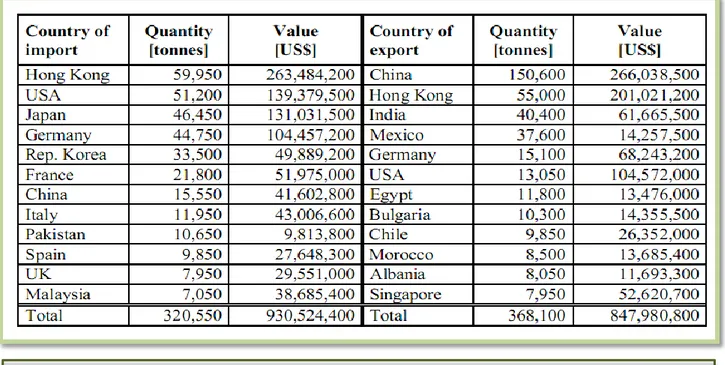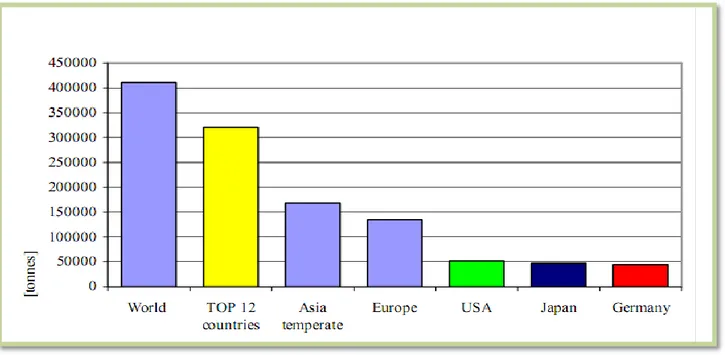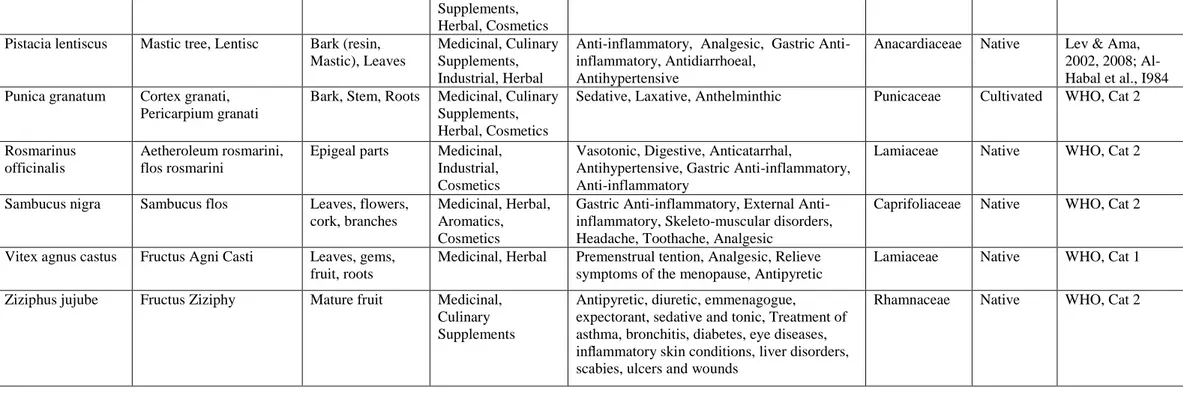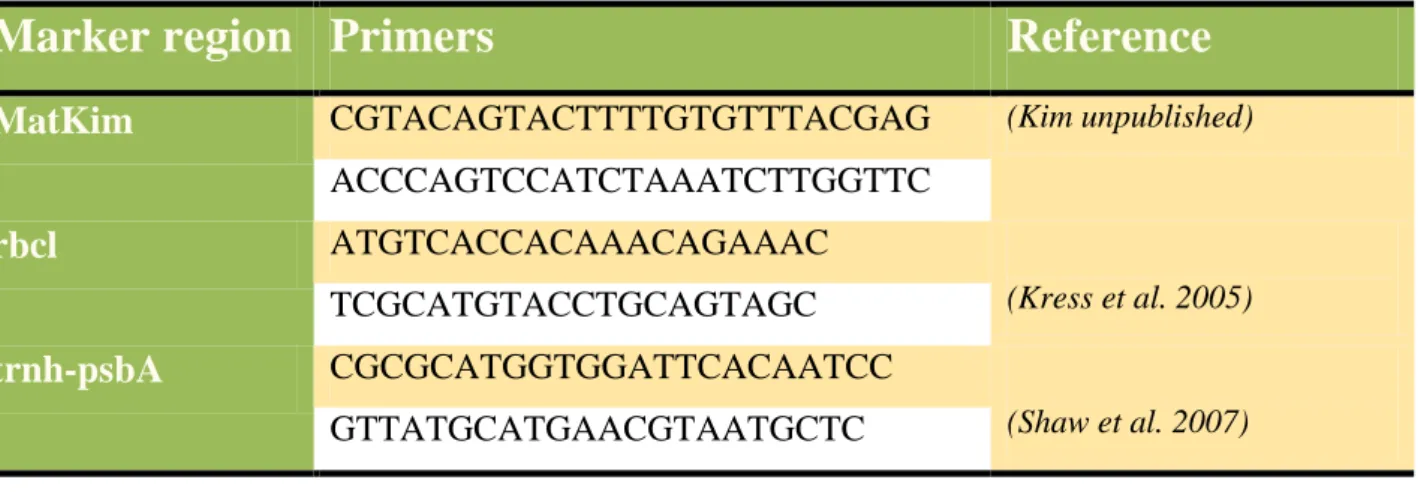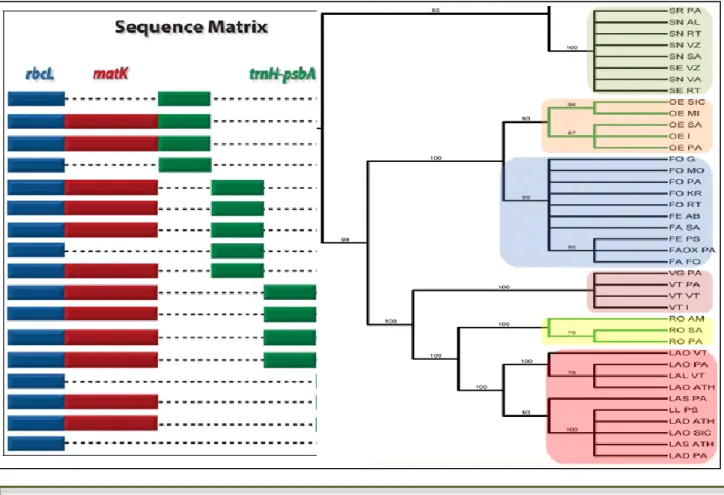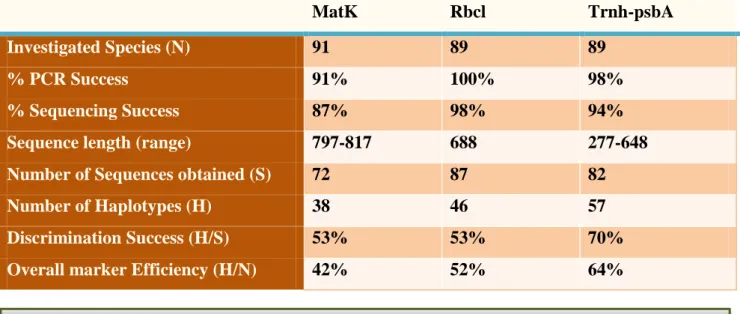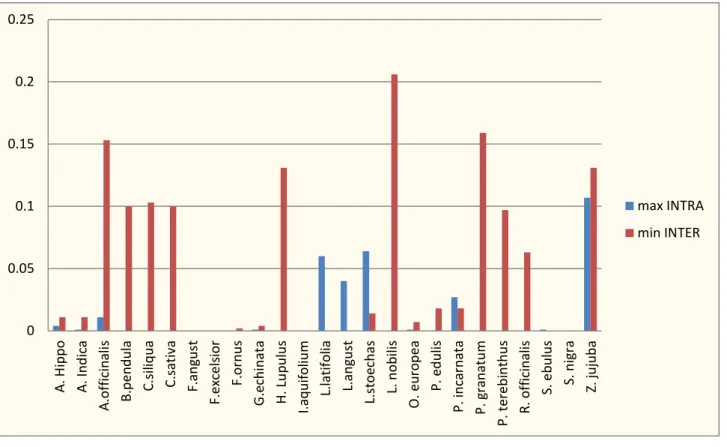Il Dipartimento di Scienze e Tecnologie per l’Agricoltura, le Foreste,
la Natura e l’Energia
DAFNE
Presentazione annuale dell’attività di :
Dottorato di ricerca (XXV CICLO)
“Scienze e tecnologie per la gestione forestale e ambientale”
Progetto di tesi:
AFFIRMATION OF DNA BARCODING AS A POWERFUL TOOL
IN CATALOGUING MEDICINAL AND AROMATIC PLANTS IN
MEDITERRANEAN FORESTS
Settore scientifico-disciplinare: AGR/05
Coordinatore: Prof/ssa Rosanna Bellarosa
Tutor: Prof/ssa Rosanna Bellarosa
Co-tutor: Dott/ssa Roberta Piredda
3
~ Στους γονείς οφείλομεν το ζην στους δε διδασκάλους το ευ ζην
4
Contents
PART I
I. Introduction
………..81. History of Medicinal and Aromatic plants………8
1.1. In ancient times………..8
1.2. Arabic and Greek legacies………10
1.3. In the Middle Ages……….10
1.4. Herbal Medicine Today. ………...11
2. Efficacy of Medicinal and Aromatic plants 2.1 MAPs utilization………..12
2.2 Species in Use & Economic value………...13
3. Ethnobotany of Mediterranean region 3.1 Toxicity complication of MAPs & identification problems………..15
3.2 Selected plant species for study………...15
3.3 Plant species monographs………...16
3.3.1AESCULUS HIPPOCASTANEUM L. ………..18
3.3.2ALTHAEA OFFICINALIS L. ………..19
3.3.3BERBERIS VULGARIS L. ……….20
3.3.4BETULA PENDULA ROTH. ………..21
3.3.5CASTANEA SATIVA MILL. ………...22
3.3.6CERATONIA SILIQUA L. ……….23 3.3.7CERCIS SILIQUASTRUM L. ……….24 3.3.8FRAXINUS EXCELSIOR L. ………...25 3.3.9FRAXINUS ORNUS L. ……….26 3.3.10GINKGO BILOBA L. ……….27 3.3.11GLYCYRRHIZA GLABRA L. ………28 3.3.12HUMULUS LUPULUS L. ………...29 3.3.13ILEX AQUIFOLIUM L. ………..30 3.3.14LAURUS NOBILIS L. ……….31
3.3.15LAVANDULA ANGUSTIFOLIA Mill. ………..32
3.3.16 LAVANDULA LATIFOLIA Medik. ………...33
5 3.3.18.PASSIFLORA INCARNATA L. ………35 3.3.19PISTACIA LENTISCUS L. ………...36 3.3.20PUNICA GRANATUM L.………37 3.3.21ROSMARINUS OFFICINALIS L. ………..38 3.3.22SAMBUCUS NIGRA L. ………...39
3.3.23VITEX AGNUS CASTUS L. ……… 40
3.3.24ZIZIPHUS JUJUBE MILL. ……… 41
4. Molecular technology as a reliable tool towards the generation of universal standards. 4.1 DNA barcoding, a powerful tool for species identification………44
4.2 Selection of barcode locus………..44
4.3 Characteristics of the selected barcode locus……….46
II. Materials and Methods
1. Plant material………...472. DNA Extraction, Polymerase Chain Reaction (PCR), Amplification and Sequencing …………..50
3. Sequence editing, alignment and assembly into a supermatrix……….52
III. Results
1. Sequencing characterization………...552. Markers’ discrimination ability………...56
3. Barcoding gap……….57
4. Tree-based analysis………...60
5. GenBank assessment……….64
IV. Discussion
1. Applications of DNA barcoding in medicinal and aromatic plants……….722. BLAST identification………...72
3. Universality and variability of DNA barcodes in the medicinal and aromatic plants of Mediterranean forests………...74
4. Contribution to conservation………...77
6
Tables’ contents
Contents
Tables
Tab. 1
The 12 leading countries of import or export of MAP...
13Tab. 2 Medicinal properties of the analyzed plant species……….43
Tab. 3 List of analyzed specimens divided in different families ... 49
Tab. 4 List of primers used for amplification of the three candidate DNA barcoding markers ... 50
Tab. 5 Markers’ main features and discrimination ability within the investigated dataset. ... 54
Tab. 6 Haplotypes list ... 64
Tab. 7 Specimens present in GenBank ... 65
Tab. 8 Specimens not present in GenBank ... 65
Tab. 9NCBI identification success at species level..………..68
Tab. 10 NCBI identification success at genus level………..71
Figures
Fig. 1 The dominating countries in the international trade in pharmaceutical plants………. 14Fig. 2 Methodology of MAP’s via DNA barcoding………...……...………... 51
Fig. 3 Schematic representation of species monophyly with supermatrix approach……….... 53
Fig. 4 Presence of a poly-T structure in trnh-psbA in a Sambucus species……… 56
Fig. 5 Relative distribution of intra-specific divergence using Kimura 2 parameters model for MatK locus……….. 58
Fig. 6 Relative distribution of intra-specific divergence using Kimura 2 parameters model for rbcl locus 59 Fig. 7 Relative distribution of intra-specific divergence using Kimura 2 parameters model for trnh-psbA locus 59 Fig. 8 Mean value of inter-specific divergence using Kimura 2 parameters model for both MatK and rbcl loci 60 Fig. 9 Species monophyly through inference of RAXML dendrogram……….. 62
Images
Imag. 1 The entrance to Shanidar Cave in northern Iraq……….. 87
Imag. 2 Hippocrates……….. 10
Imag. 3 Flag of the World Health Organization……….. 11
Imag. 4 Hardened resin………... 36
Imag. 5 Samples collection in botanical garden of Padova, Italy……… 47
Imag. 6 Samples collection in botanical garden of Ethiage, Thessaloniki, Greece……….. 47
PART II
I. Introduction
………. 89II. Materials and Methods
………... 902.1 Plant material……….. 90
2.2 Extraction procedure……….. 90
2.3 HPLC analysis………... 90
III. Results and Discussion
……… 91IV. Bibliography
………. 103Acknowledgements
………..………..………..………..……….. 105Tables’ contents
Figures
Fig. 1 Typical chromatogram of the total extract from T. baccata L……….. 93Fig. 2 Monthly variation of taxol content………. 94
Fig. 3 Monthly variation of taxol content at Carpineto Romano stand……….. 95
Fig. 4 Mean monthly variation of Taxol content grouped by sex expression at Carpineto Romano… 96 Fig. 5 Mean monthly variation with standard deviation of Taxol content grouped by sex expression at Carpineto Romano………... 97
Fig. 6 Monthly variation of taxol content related to mean air temperature………. 100
Fig. 7 Monthly variation of taxol content related to mean ground temperature……….. 101
Fig. 8 Monthly variation of taxol content related to relative humidity……….. 102
Tables
Tab. 1 Mean monthly Taxol content ± standard deviation in study provenances……… 98Tab. 2 Mean monthly taxol content ± standard deviation at Carpineto Romano, grouped by sex expression………. 99
8
I.
Introduction
1. History of Medicinal and Aromatic plants
1.1 In ancient times
In 1960, at the cave site of Shanidar in what is now north-eastern Iraq, the skeleton of an adult male
was discovered, lying on his left side in a partial foetal position. He had been buried some 60,000
years ago. Routine soil samples were gathered for pollen analysis in an attempt to reconstruct the
site’s palaeoclimate and vegetational history.
In some of the samples concentrated clumps of
pollen were found suggesting that entire
flowering plants had been buried close to the
man. Though the source of the pollen is hotly
debated, a study of the particular flower
types suggested that the flowers may
have been specifically chosen for their
medicinal properties. Yarrow (Achillea
spp.), St. Barnaby’s thistle (Centaurea
spp.), groundsel (Senecio spp.) and rose
mallow (Hibiscus spp.) amongst others
were represented in the pollen samples,
all of which have long known curative
powers as stimulants, astringents and anti-inflammatories (Solecki 1976).
The history of medicinal plants is essentially the history of mankind itself, every culture and
civilization has used plants extensively since prehistory. A cultural fact useful to explain what may
have happened in the past is the study of several contemporary rural sites in South America, where
each ethnic group has an extensive knowledge of local flora, cultivates its own medicine garden and
provides information on the medicinal powers of diverse native plants.
Cultural tradition and personal dedication to experiment with diverse plants can explain the
accumulation of knowledge by native people aware of the potential contribution of nature to
human’s life. That ability also found in wild animals and even in some domesticated animals (cats,
dogs), is a faculty used by these ethnic groups habituated to live closed to nature, compared to
urbanized people who have lost this capacity, becoming unable to recognize which plants to choose
for a natural remedy.
Imag. 1 The entrance to Shanidar Cave in northern Iraq- Partial skeleton in situ in Shanidar Cave.
9
There is no doubt that the earliest drug used as an analgesic was the product of sugar fermentation
in solution by yeast (ethanol). Alcohol was produced “when crushed grapes of berries in water were
left standing in a warm place”, as far back as 6400BC. The technique of distillation introduced to
Europe by Arabic cultures during the middle ages, enabled alcohol to be concentrated at high levels.
Since the very beginning alcoholic beverages became the ‘wonder drink’ capable of producing
relaxation, elevation of mood, increased appetite and release of inhibition. Later alcohol has been
used as an anxiolytic, soporific, hypnotic, analgesic, astringent, bactericidal and also as a solvent
(Ortega 2004).
Undisputedly, the history of herbology is inextricably intertwined with that of modern medicine.
Many drugs listed as conventional medications were originally derived from plants. Salicylic acid, a
precursor of aspirin, was originally derived from white willow bark and the meadowsweet plant.
Cinchona bark is the source of malaria-fighting quinine. Vincristine, used to treat certain types of
cancer, comes from periwinkle. The opium poppy yields morphine, codeine, and paregoric, a
treatment for diarrhea Laudanum, a tincture of the opium poppy, was the favored tranquilizer in
Victorian times. Even today, morphine-the most important alkaloid of the opium poppy-remains the
standard against which new synthetic pain relieves is measured (Ortega 2004).
In 2735 B.C., the Chinese emperor Shen Nong wrote an authoritative treatise on herbs that is still in
use today, the use of Ma Huang (known as ephedra in the Western world), mostly used against
respiratory distress. Ephedrine, extracted from ephedra, is widely used as a decongestant. In 1800
B.C records of King Hammurabi of Babylon include instructions for using medicinal plants. He
prescribed the use of mint for digestive disorders. Modern research has confirmed that peppermint
does indeed relieve nausea and vomiting by mildly anesthetizing the lining of the stomach (Ortega
2004).
The entire Middle East is characterized by a rich history of herbal healing. There are texts still
survived from the ancient cultures of Egypt, Mesopotamia and India that describe and illustrate the
use of many medicinal plant products, including castor oil, linseed oil, and white poppies. In the
scriptural book of Ezekiel, which dates from the sixth century B.C., it can be find this admonition
regarding plant life: "..and the fruit thereof shall be for meat, and leaf thereof for medicine."
Egyptian hieroglyphs show physicians of the first and second centuries A.D. treating constipation
with senna pods, and using caraway and peppermint to relieve digestive upsets (Ortega 2004).
10
1.2 Arabic and Greek legacies
Approximately 1000 years ago, Baghdad became a recognized focal point of medicinal learning.
Muslim, Jewish and Christian scribes and scholars cooperated
in making available a wealth of texts, by
Persians-Mesopotamian, Byzantine-Greek and Indian traditions. The
theory and practice of medicine in the first millennium was
preserved for us in a series of books such as The ROYAL
Book of All Medicine by Ali ibn Abbas al-Majusi (Haly
Abbas, d 994), the Canon of Medicine by ibn Sina (Avicenna,
d. 1037) etc.. The essence of these medicinal writings flowed
west to Damascus, Cairo, Palermo and Cordoba having been
translated exerting a strong influence on the first university
curricula.
The emerging universities of the 12
thcentury European
western culture, received the strong influence of the writings of
Hippocrates of Cos (4
thB.C.); the founder of allopathic
medicine, is considered to be the first Unani (Ἰωνία or Ἰωνίη) physician and Galen of Pergamum
(2
ndC.E.) translated into Latin. (Baytop, 1999). The Hippocratic foundations were complemented,
possibly by Byzantine teachers before the 8
thcentury, with Galen’s “Art of Medicine” or
“Articella”.
1.3 In the Middle Ages
Remarkable is during the Middle Ages too, home-grown botanicals were the only medicines
readily available, and for centuries, no self-respecting household would be without a carefully
tended and extensively used herb garden. For the most part, herbal healing lore was passed from
generation to generation by word of mouth. Mother taught daughter; the village herbalist taught a
promising apprentice.
By the seventeenth century, the knowledge of herbal medicine was widely disseminated
throughout Europe. In 1649, Nicholas Culpeper wrote A Physical Directory, and a few years later
produced The English Physician. This respected herbal pharmacopeia was one of the first manuals
that the layperson could use for health care, and it is still widely referred to and quoted today.
Culpeper had studied at Cambridge University and was meant to become a great doctor, in the
academic sense of the word. Instead, he chose to apprentice to an apothecary and eventually set up
Imag. 2 Hippocrates- also considered as the ‘Father of Medicine’
11
his own shop. He served the poor people of London and became known as their neighborhood
doctor. The herbal he created was meant for the layperson.
The first U.S. Pharmacopeia was published in 1820. This volume included an authoritative listing of
herbal drugs, with descriptions of their properties, uses, dosages, and tests of purity. It was
periodically revised and became the legal standard for medical compounds in 1906. But as Western
medicine evolved from an art to a science in the nineteenth century, information that had at one
time been widely available became the domain of comparatively few. Once scientific methods were
developed to extract and synthesize the active ingredients in plants, pharmaceutical laboratories
took over from providers of medicinal herbs as the producers of drugs. The use of herbs, which for
most of history had been mainstream medical practice, began to be considered unscientific, or at
least unconventional, and to fall into relative obscurity.
1.4 Herbal Medicine Today
During the past decade, traditional systems of
medicine have become a topic of global importance.
Current estimates suggest that, in many developing
countries, a large proportion of the population relies
heavily on traditional practitioners and medicinal plants
to meet primary health care needs. Although modern
medicine may be available in these countries, herbal
medicines (phytomedicines) have often maintained
popularity
for
historical
and
cultural
reasons.
Concurrently, many people in developed countries have
begun to turn to alternative or complementary therapies, including medicinal herbs.
The World Health Organization (W.H.O.) estimates that 4 billion people, 80% of the world
population, presently use herbal medicine for some aspect of primary health care. Herbal medicine
is a major component in all indigenous peoples’ traditional medicine and a common element in
Ayurvedic, homeopathic, naturopathic, traditional oriental, and Native American Indian medicine.
W.H.O. notes that of 119 plant-derived pharmaceutical medicines, about 74% are used in modern
medicine in ways that correlated directly with their traditional uses as plant medicines by native
cultures. Major pharmaceutical companies are currently conducting extensive research on plant
materials gathered from the rain forests and other places for their potential medicinal value.
Imag. 3Flag of the World Health Organization
12
Rather than using a W.H.O.le plant, pharmacologists identify, isolate, extract, and synthesize
individual components, thus capturing the active properties. This can create problems, however. In
addition to active ingredients, plants contain minerals, vitamins, volatile oils, glycosides, alkaloids,
bioflavanoids, and other substances that are important in supporting a particular herb's medicinal
properties. These elements also provide an important natural safeguard. Isolated or synthesized
active compounds can become toxic in relatively small doses; it usually takes a much greater
amount of a W.H.O.le herb, with all of its components, to reach a toxic level. Herbs are medicines,
however, and they can have powerful effects.
2. Efficacy of Medicinal and Aromatic plants
2.1 MAPs utilization
Medicinal and aromatic plants (MAPs) as mentioned above have been used by mankind for
millennia; their use is as old as humanity itself. From the pre-historic era, men have been using
plants as medicine and in recent years, interest in the exploitation
of plants as pharmaceuticals, herbal remedies, flavourings, dietary
supplements, homeopathics, medicinal and herbal teas, liqueurs,
spirits, sweets, aromas and essences, perfumes, cosmetics, coloring
agents, varnishes, fireworks, and detergents and other natural
products has greatly increased (Iqbal 1993; Walter 2001; Rao &
Arora 2004).
Whereas in some goods the herbal ingredients are
evident, e.g. in teas or in herbal remedies where they
are declared on the packaging, in other products the
botanically source is more secret: the bitter taste of
Campari is based on the Common Centaury
(Centaurium erythraea), and the fenugreek (Trigonella
foenum-graecum) contains steroid-saponins which are
extracted for use in oral contraceptives. The use of
botanical raw material is in many cases much cheaper
than to use chemical alternative substances (Lange 2004).
Through evolution, plants have developed large numbers of chemical substances to defend
themselves against insect pests, and fungal and other pathogenic diseases. Some of these chemicals
can also fight against micro-organism and other diseases in the human body. They represent an
13
important source of natural drugs. Their highly complex molecular structures often surpass the
imagination of the chemist and cannot easily be reproduced in the laboratory (Seters 2003).
2.2 Species in Use & Economic value
The range of species used and their scope for healing is vast. Cures as yet undiscovered may
exist in plants as yet undescribed. Currently, it is estimated that the number of higher plant species
used worldwide for medicinal and aromatic purposes is more than 50,000 (Schippmann et al.,
2002). This equates to approximately 20% of the world’s vascular flora and constitutes the biggest
spectrum of biodiversity used by people for a specific purpose (Hamilton et al., 2006).
Medicinal and aromatic plants harvested from the wild remain of immense importance for the
well-being of millions of people around the world. MAPs are clearly an important global resource in
terms of healthcare but they are also an important economic resource, traded extensively on scales
ranging from the local to the international. Internationally, the trade in medicinal and aromatic
plants is estimated to be worth $60 billion per year (World Bank, 2004) increasing at a rate of 7% a
year (Koul and Wahab, 2004). Loss of habitat combined with over-harvesting threatens the survival
of many of these plant species.
Tab. 1 The 12 leading countries of import or export of MAP material classified as pharmaceutical plants (SITC.3: 292,4= commodity groups HS 1211). The countries are listed according to descending
order of average trade volumes, 1991-2003 (COMTRADE database, United Nation Statistics Division, New
14
About 2,000 medicinal and aromatic plant species are used on a commercial basis in Europe, of
which two-thirds are native to Europe. In the EU, medicinal and aromatic plants are cultivated on an
estimated 70,000 ha. Leading species are: lavender (Lavandula spp.), Opium Poppy (Papaver
somniferum), Caraway (Carum carvi) and Fennel (Foeniculum vulgare). France and Spain are EU
countries with many hectares under cultivation. However, in Spain wild-harvesting and cultivation
of medicinal and aromatic plants has declined. There is some cultivation in Germany, where leading
producers of herbal medicines have their own plantations for popular products. Eastern European
countries such as Bulgaria, Hungary and Albania are major EU suppliers of material from medicinal
and aromatic plants.
In 2000, Germany was, by far, the leading EU importer of medicinal & aromatic plants. Between
1998 and 2000, however, Germany saw its share in EU imports decrease from 38 percent to 29
percent, while the United Kingdom experienced an increase from 7 to 12 percent. The Netherlands
was small importer of medicinal & aromatic plants, being only the 12th leading EU importer.
The major importing markets are the EU and USA. In these countries, increased demand for
medicinal plants is being fuelled primarily by consumer interest in natural products and remedies,
as well as by increasing concerns about the possible side effects of allopathic medicines. Major
Fig. 1 The dominating actors, countries and regions, in the international trade in pharmaceutical plants (SITC.3: commodity group 292.4) and their average import quantities in tones for the period
15
developing countries such as China and India are exporting medicinal plants, herbal tonics,
cosmetics, perfumes etc. There are therefore good prospects for export growth from LDCs in this
market. However, markets in developed countries for herbal medicine -especially in Europe and the
USA - are highly regulated and are very difficult to penetrate, particularly for developing countries
and LDCs W.H.O.se products have not undergone the stringent tests applied by developed country
pharmaceutical manufacturers before mass production (India Trade Promotion Organization-ITPO)
(
http://www.tradeportalofindia.com/contentmgmt/Desktops2.html?compid=itpo&itemcode=I087).3. Ethnobotany of Mediterranean region
The Mediterranean Basin biodiversity hotspot is the second largest hotspot in the world and the
largest of the world’s five Mediterranean-Climate regions. The hotspot covers more than 2 million
square kilometers and stretches west to east from Portugal to Jordan and north to south from
northern Italy to Cape Verde (Mittermeier et al. 2004). It is one of the areas with the greatest
diversity on the planet, and thus it is considered that it should be maintained as a conservation
sanctuary (Myers et al., 2000). Approximately, 30,000 plant species occur and more than 13,000 are
found nowhere else, or endemic, to the hotspot, yet many more are being discovered every year
(Radford et al., 2011). The Mediterranean Basin is the third richest hotspot in the world in terms of
its plant diversity (Mittermeier et al. 2004). Therefore, the radical trapping properties of the
Mediterranean flora, comprising more than 10000 plant species with various properties
(anti-inflammatory, diuretic and so on), deserve further investigation.
Arguments such as species richness and uses, migration, cultural shift or the disappearance of the
communities are put forward to prioritize ethnobotanical studies in places such as Amazon. These
same reasons continue to be valid in industrialized countries or emerging countries, such as those of
Mediterranean Basin, where the alternation of the physical and biological environment, rural
depopulation, the new means of communication, etc. are causing an accelerated loss of traditional
knowledge, making these types of studies perhaps even more urgent.
3.1 Toxicity complication of MAPs & identification problems
However, several spontaneous plants are potentially toxic for human beings (Ngogang J. et al.
2008; Tinggi U. 2003; Vetter J. 2000; Xia Q. et al. 2008). The accidental ingestion of toxic plant
portions (for instance seed, fruit, root, etc.) can cause severe poisoning or even death (McIntire MS.
et al. 1990; Vetter J. 2000). Hence, plant medicinal or aromatic materials may be substituted
accidentally by taxa from closely related species or adulterated intentionally by materials from
unrelated plants. In the last years, the plant exposures are among the most frequent poisoning cases
16
reported by poisoning control centers (Mrvos R. 2001). More precisely, in 2002, 63 people were
reported with syptoms of general malaise, nausea and vomiting after consumption of herbal tea
which was inadvertently mixed with neurotoxic Japanese star anise (Illicium anisatum) (Johanns
E.S. et al. 2002). Adulteration resulting in an epidemic of severe kidney damages caused by
aristolochic acid was first reported in Belgium in 1993 (Vanherweghem J.L. et al. 1993), followed
by Hong Kong and Korea (Lo S.H. et al. 2004; Lee S. et al. 2004) in 2004.
Nevertheless, the identification of herbal medical materials using traditional, organoleptic and
chemical methods can be difficult, particularly for those materials derived from the processed parts
of a plant or in powder form. Therefore, an accurate, universal, stable and specific marker allowing
non-specialists to identify the source species from a tiny amount of tissue is undoubtedly beneficial.
Molecular technology is believed to be a reliable alternative tool for the identification of herbs
(Shaw et al. 1997; Kaplan et al. 2004) and DNA barcoding is the latest move towards the generation
of universal standards (Chen et al. 2010; Heubl, 2010). DNA barcoding has become a major focus
in the biodiversity and conservation fields in recent years.
3.2 Selected plant species for study
Few plant species that provide medicinal herbs have been scientifically evaluated for their
possible medical application. Safety and efficacy data are available for even fewer plants, their
extracts and active ingredients, and the preparations containing them. Furthermore, in most
countries the herbal medicines market is poorly regulated, and herbal products are often neither
registered nor controlled. Assurance of the safety, quality, and efficacy of medicinal plants and
herbal products has now become a key issue in industrialized and in developing countries. Both the
general consumer and health-care professionals need up-to-date, authoritative information on the
safety and efficacy of medicinal plants.
During the fourth International Conference of Drug Regulatory Authorities (ICDRA) held in Tokyo
in 1986, W.H.O. was requested to compile a list of medicinal plants and to establish international
specifications for the most widely used medicinal plants and simple preparations. Guidelines for the
assessment of herbal medicines were subsequently prepared by W.H.O. and adopted by the sixth
ICDRA in Ottawa, Canada, in 1991.
As a result of ICDRA’s recommendations and in response to requests from W.H.O.’s Member
States for assistance in providing safe and effective herbal medicines for use in national healthcare
systems, W.H.O. has published 4 volumes on selected medicinal plants so far; volume 1 includes 28
monographs; volume 2 contains an additional 30 monographs; volume 3 provides 31 monographs
17
and volume 4 contains 28 new monographs published, a total of 118 monographs in four volumes
(W.H.O. 2009).
Consequently, in this doctorate thesis, it has been decided to be included for analysis some of these
plant species that have been proposed by the published lists of W.H.O., naturally occurred in
Mediterranean Basin (mainly in Italy and Greece, most of them) divided into different categories
according to their importance in medicine.
18
3.3 Plant species monographs
3.3.1 AESCULUS HIPPOCASTANEUM L.
English name: Horse Chestnut, Family: Sapindaceae
Habitat: Native to south-eastern Europe (Balkans), widely planted as an ornamental tree in parks and along roads, occasionally naturalized Fruit shell with short spikes
Seed
(‘conker’)While conventional medicine
uses mainly the saponin (aescin)
containedin the seeds, folk
medicine also utilizes the leaves,
flowers and bark of the Horse
Chenstnut tree. Aescin, also
known as horse chestnut extract,
is used in preparations for
venous insufficiency, varicose
veins,
oedema
and
haemorrhoids. In addition Horse
Chestnut rubs and bath oils are
recommended for bruices and to
improve
circulation.
Folk
medicine uses the leaves for
rheumatic
complaints,
haemorrhoids, thrombosis and
other venous diseases.
Leaves palmate Flowers bi-or unisexual Flowers in upright racemes Leaflets up to 20cm long
Petals white with a distinct pink mark 10-15mm long
H. up to 20m, F.S. May-June
Health tip:
Horse Chenstnut preparations are available for most of the plant’s main indications. This is a traditional household remedy: use a tincture of Horse Chenstnut leaves, flowers and bark soaked in brandy as a rub to ease rheumatic pain.
19
3.3.2 ALTHAEA OFFICINALIS L.
English name: Marsh Mallow, Family: Malvaceae
Health tip:
Soak 1-2 tsp of chopped Marsh Mallow root in a cup of cold water for about 1h. then heat slowly to the desired temperature and strain. Alternatively, place 1-2 tsp. of Marsh Mallow leaves in a cup and add hot (but not boiling) water. Strain after 10’.
Anthers purple
Marsh Mallow has been used as a medicinal plant since antiquity and is still an accepted remedy in herbal medicine today. A tea made from its leaves, flowers or roots helps alleviate oral and throat infections as well as gastro-intestinal complaints. The plant may even have immune-boosting properties. Marsh Mallow tea with honey is a popular cough remedy and Marsh Mallow poultices are applied in folk medicine for a variety of skin conditions.
Habitat: Moist ground, salt marshes, on loamy soils. Asia, Eastern Europe, coastal areas
Escapes from gardens often found in the wild Entire plant is covered in a soft down Outer sepals joined at base, petals lobed at the top Flower 3-5cm across Flowers pale pink, in dense clusters Root up to 50cm deep H 60-1, 20 cm FS. July-Sept.
20
3.3.3 BERBERIS VULGARIS L.
English name: Common Barberry, Family: Berberidaceae
6 petals and 6 sepals Flowers in pendent racemes Clusters with many yellow
flowers Oblong berries,
up to 1cm long
Habitat: Forests margins, hedgerows, open pine forests. Europe to western Asia. Deciduous Leaves in bunches Flowers have an intense, slightly unpleasant fragrance
The refreshingly tart fruits of this shrub are rich in vitamin C and can be used in jams and compotes. Folk medicine uses them as a laxative and for liver and spleen problems. The poisonous bark of the root, too, was used in the past as a remedy for gall bladder complaints, jaundice, digestive disorders, diarrhea, kidney stones, rheumatism and numerous other ailments. Tough leaf, 2-6cm long Margin with prickly teeth H. 2-3m FS. May-June Long, very sharp spines, often in threes
21
3.3.4 BETULA PENDULA ROTH.
English name: Silver Birch, Family: Betulaceae
Dried Silver Birch leaves are mildly diuretic, without over stimulating the kidneys and are recommended for urinary tract infections. In folk medicine, an infusion from the leaves is used to ease rheumatic pain and gout and a decoction from the leaves and bark is applied as a skin tonic. The fresh sap, harvested in early spring, was recommended as a remedy for thinning hair
Habitat: Mixed and deciduous forests, rough grassland, heaths and moors, wasteland. Europe, western Asia
deciduous male catkins
pendant
tiny seeds with 2 small, transparent wings on either side Leaves almost diamond-shaped Male catkins 10cm long Male flowers yellowish-brown Female flowers initially upright, later drooping Crown, elongated, sparse Branches mostly projecting from trunk at a sharp angle Twigs thin, usually hanging H. 8-25m FS. April- May
22
3.3.5 CASTANEA SATIVA
English name: Sweet Chesnut, Family: Fagaceae
Chestnuts are not just a popular stuffing ingrendient for the Christmas turkey, in the tree’s native regions they are also known as a gentle household remedy for diarrhea. However, the real medicinal power is in the leaves, which are rich in tannins and are known in folk medicine as a remedy for coughs and sore throats (as a gargle), circulatory problems, aching legs and diarrhea.
Spiky fruit shell Edible seeds
Habitat: Native to south-western Asia and southern Europe
Male flowers in long upright catkins
Female flowers below male ones Very spiky fruit
shell
Leaves up to 30cm long
Health tip:
Chestnut leaf tea for respiratory complaints: use 2 tsp of finely chopped leaves per cup, add cold water and bring to the boil. Strain immediately and leave to cool. Drink 2-3 cups per day at intervals.
H. up to 30m FS. June Margin roughly serrated Firm, slightly leathery
23
3.3.6 CERATONIA SILIQUA L.
English name: Carub, Locust Tree, Family: Fagaceae
The seeds of this tree have a constant weight of 0.18gr/the equivalent of 1 carat/and have in the past been used to assess the value of jewels. A flour extracted from the seeds is largely indigestible and is used as a bulking and gelling agent in baby and diet foods and pharmaceutical products. In some parts of the world, the seed shells are used as household remedy for diarrhea.
Habitat: Maquis, rocky slopes. On nutrient-poor soils. Mediterranean region, western Asia, northern Africa
evergreen
leaves even-pinnate flowers grow directly
from the branches very distinctive due to
late flowering season and prolific flowers poisonous Smooth margin Oval leaflet Seed pods up to 20cm long Fruits Flowers without petals
yellowish-white, up to 2cm in size Flowers grow directly from the branches H. 2-10m FS. July-September
24
3.3.7 CERCIS SILIQUASTRUM L
.
English name: Judas Tree, Family: Fagaceae
Back in Biblical times, this tree ornamented the gardens of Judea and according to legend, Judas hanged himself from one. The flowers were supposedly white originally, taking on their pink hue after the crucifixion of Christ. The flowers can be used to garnish salads, but the fruits are inedible.
6-15cm long, flat, hard pod Pea like flowers up
to 2cm long, pink
Generally with multiple stems
Habitat: Originally in the eastern Mediterranean. As an ornamental tree in southern and central Europe. Flowers in clusters on twigs and trunk
Hardly but prefers mild locations One of the most
popular
ornamental trees in southern Europe Fruits on the tree
in winter Rough, leathery, hairless Base heart-shaped Leaf up to 11cm long, round to kidney-shaped Crown broadly spreading, often irregular H. 3-10m FS. May
25
3.3.8 FRAXINUS EXCELSIOR L.
English name: Common Ash, Family: Oleaceae
The leaves and bark of the Common Ash are used in folk medicine and homeopathy, though not in conventional medicine. The leaves contain tannins, mucilage and plant acids. They are taken in teas as a diuretic and gentle laxative, to relieve rheumatic complaints, gout and stones and are used to treat slow-healing wounds.
Habitat: Mixed and lowland forests, along rivers and streams, Europe, Asia Minor to Caucasus.
deciduous
colonizing tree, also on dry ground flowers appear before
leaves Flowers in dense clusters H. up to 40m FS. April-May Leaves odd- pinnate Bunches of Ash keys Ash fruits, known as ‘keys’ Leaflet
26
3.3.9 FRAXINUS ORNUS L.
English name: Manna Ash, Family: Oleaceae
Manna from dried bark exudate
The Manna produced by this tree has nothing but its name in common with the Biblical manna. Nevertheless, this dried exudate from the bark was a popular delicacy in mediaeval times-imports of manna from Sicily is recorded in Venice as early as the 9th century. Its main ingredient is mannitol, a sugar alcohol, which is used as a gentle laxative and a sugar substitute for diabetics.
Habitat: Forest margins, hedgerows, lowland forests, along the banks of streams. On nutrient-rich soils. Europe, Asia Minor.
Green brunches angular with narrow cork wings
Leaves opposite
Curiosity:
In early history the Greeks used to make lances and spears from the wood of this tree. Nemesis, the Greek Goddess of justice, carried a branch of the tree in her hand as a symbol of her fair decisions. H. 5-15m FS. May-June Fruits up to 4cm long, hang in bundles Scented flowers Leaves odd-pinnate
27
3.3.10 GINKGO BILOBA L.
English name: Ginkgo, Family: Ginkgoaceae
Ginkgo leaves are prescribed in Traditional Chinese Medicine for asthmatic complaints. In western herbal medicine, preparations from Ginkgo leaves are sold as a herbal supplement, said to stimulate brain activity. Studies have shown that Ginkgo improves blood flow to the brain but claims that this may assist in the treatment of Alzheimer’s disease have yet to be scientifically proven.
Habitat: Native to China, grown worldwide as an ornamental tree. Deciduous, golden-yellow autumn color Botanically related to conifers, despite being a deciduous, broad leaved tree Male and female
flowers on separate plants
Curiosity:
Ancestors of the Ginkgo, which were very similar to today’s species, populated the Earth back in the Jurassic period. The Ginkgo is the sole survivor of this group, making it a living fossil. One Ginkgo tree even survived the atom bomb attack in Hiroshima and the tree has been a symbol of hope for the Japanese ever since.
Distinctive, fan-shaped leaves Ripe fruits round, 2-3cm in diameter H. up to 30m FS. March-April
28
3.3.11 Glycyrrhiza glabra
English name: Liquorice, Family: Fagaceae
Leaflets long, oval Fibrous root Habitat: Eastern Mediterranean, South-Eastern Asia.
Root yellow inside, sweet-tasting Leaves pinnate Leaflets long, oval,
underside feels sticky
In addition to its use in confectionery, Liquorice root is applied medicinally for its expectorant and demulcent properties, e.g. in cough syrups and gastritis remedies. The root contains glycyrrhizin, a substance that is 50 times sweeter than sucrose and has long been used as a flavouring in other medicines to mask their unpleasant taste. It should be used in moderation, however, as prolonged use can raise blood pressure and affect hormonal balance. Flowers in tall, upright racemes H. up to 30m FS. March-April Racemes 8-15cm tall
29
3.3.12 Humulus lupulus
English name: Hops, Family: Cannabaceae
H.
200-400cm FS. July-Aug
Only the unfertilized female plants are cultivated for beer-making. The bitter agents accumulated in their flower heads (known as ‘cones’ or ‘strobiles’ ) are responsible for the drink’s taste. In herbal medicine, the plant is used as a mild sedative and sleep aid. Folk medicine recommends a tea made from Hops for loss of appetite and as a digestive. In mediaeval times it was used to curb sexual desire. Skin contact with the plant can cause dermatitis in some people.
Lower leaves with 3-5 lobes
Upper leaves simple
Habitat: Lowland forests, forest margins, wasteland sites, on fences, mainly in cultivation. Throughout Europe, south-western Asia, North America
Male and female flowers on separate plants
Climbing and trailing plant
Hop cones (female flowers) pendant
30
3.3.13 Ilex aquifolium C.
English name: Holly, English Holly Family: Aquifoliaceae
The leaves of the Holly tree, not its poisonous berries, are the parts of most medicinal interest. They are used in homeopathic remedies for flue, conjunctivitis and other eye infections; folk medicine recommends them for fevers, rheumatic complaints and bronchitis; and in Bach flower remedies, Holly helps to overcome irritability, anger, envy and suspicion.
Habitat: forests. In sandy or stony ground. Western and Central Europe., including Britain, from Norway to Germany south to the Mediterranean and North-Western Africa
Male and female flowers on separate plants
Native, evergreen woodland plant
Curiosity:
In some areas, believers still carry holly twigs to church on Palm Sunday to have them sanctified. At Christmas, springs of holly make popular evergreen decorations, particularly in Britain. They symbolize the continuation of life during winter.
Leaves dark green, shiny, leathery
Bright red berries
Leaves evergreen with sharp, spiny margins
H. 1-6m FS. May-June
Male flowers in
31
3.3.14 Laurus nobilis L.
English name: Bay Laurel, Bay Tree Family: Lauraceae
Habitat: Forests in the Mediterranean, in northern Europe as an ornamental garden plant.
Evergreen Male and female
flowers on separate plants
In Greek mythology, Bay-or Laurel-is sacred to Apollo and his son Asclepius, the gods of healing and medicine. It was held in high esteem as a medicinal plant throughout the Middle Ages and beyond. Nowadays, Bay leaves are mostly known as an aromatic flavoring in soups and stews. In folk medicine, Bay was used to treat stomach complaints and to ease rheumatic pain.
Flowers yellow to white Flowers in clusters Fruits fleshy, oval Leaf margins wavy Leaves stiff, leathery, lanceolate Curiosity:
Laurel wreaths crowned the heads of the victorious Julius Caesar and other Roman commanders. In Greece, successful athletes were also awarded this decoration. Later, students were honored with the ‘baccalaureus’, a laurel wreath with berries. The academic title of Bachelor was derived from this.
H 2-10m FS March-April
32
3.3.15 Lavandula angustifolia Mill.
English name: Common Lavender, Family: Lamiaceae
Anyone who has ever walked among the rows and rows of lavender in the French Provenance-and has seen the abundance of lavender-related products in the local souvenir shops-is unlikely to ever forget this plant. A tea from lavender flowers is said to stimulate the appetite, settle the stomach, calm the nerves and help promote sleep. Lavender,
Habitat: rocky ground, garigue. Native to southern Europe. Commonly grown as a garden ornamental shrub.
Compact,
aromatically scented shrub
Flowers in whorled spikes on long stalks, rising tal above the shrub itself Young leaves downy Flowers in whorled terminal spikes Small labiate flowers, about 10-12mm long Health Tip:
For a soothing lavender bath, add 50-60gr of lavender flowers to 1l. of water. Bring to the boil, then leave to settle for 10min. Strain and add to your bathwater. Relax in the bath and go to bed afterwards.
H 50-100cm FS July-Sept
33
3.3.16 Lavandula latifolia Medik.
English name: Spike Lavender, Family: Lamiaceae
The medicinal properties of Spike Lavender are similar to those of Common Lavender. Although the flowers yield more essential oil, it is considered of inferior quality and less fragrant than that of Common Lavender. It is used externally to treat wounds, burns and rheumatic pain; added to a steam inhalation bath it soothes catarrhs of the respiratory system; and a drop of Lavender oil on a spoonful of sugar is said to aid digestion.
Habitat: Evergreen shrubland, maquis. Southern Europe to Balkans Compact, low-growing shrub, strong, aromatic fragrance. Bracts lanceolate Underside of leaves downy Small labiate flower, 8-10mm long Flowers in spikes H 50-100cm FS July-Sept
34
3.3.17 Olea europaea spp. europaea L.
English name: Olive Tree, Family: Oleaceae
The Olive Tree has been known since biblical times. In Mediterranean folk medicine, the leaves are sometimes used in herbal teas. However, mostly the oil is used: as a lubricant, to relieve constipation or, mixed with garlic, to treat joint and muscle aches. In conventional medicine it is used as carrier oil for fat-soluble medications and in the treatment of skin conditions. Yet, above all, olive oil is valuable and cholesterol-lowering cooking oil. In Bach flower remedies, Olive is recommended for exhaustion and mental fatigue.
Habitat: Evergreen maquis, primarily in cultivation. Mediterranean region
Cultivated since antiquity Evergreen
One of the healthiest oils for use in cooking and salads
Health Tip:
Olive oil vinaigrette: mix two finely chopped shallots with some mustard and garlic to taste. Add vinegar and season with salt and black pepper. Leave for a few minutes to allow the flavors to mingle and then add 50ml of good quality cold-pressed, extra-virgin olive oil.
Underside of leaves downy
Leaves evergreen
Olives first green then deep brown to black
Flower with 4 lobes
H 6-15m FS May-June
35
3.3.18 Passiflora incarnatal L.
English name: Purple Passionflower, Family: Passifloraceae
Leaves with 3 deep lobes
H 8-10m FS May-July The name ‘Passionflower’ was coined by Christian
missionaries who saw in its flowers the symbols of the passions of Christ: the five stamens and three styles symbolize the wounds and the nails, the double raw of colored filaments represents the crown of thorns, the tendrils are the whips and the lobed leaves resemble the clutching hands of the soldiers. The leaves and flowers are sold in herbal preparations and tea mixes to relieve nervous
disorders.
Habitat: Central America, southern USA, Mexico, in Europe as a garden plant
Ornamental flower with Passion-of-Christ symbolism Climbing plant 3 styles 5 stamens Corona of fine filaments Flower pink or white, 3-5cm across
36
3.3.19 Pistacia lentiscus L.
English name: Mastic Tree, Family: Anacardiaceae
Male flowers in small racemes
The Greeks, on the island of Chios in particular cultivate tree-like specimens, to extract the Mastic resin. Mastic, the resin from this tree, is obtained from incisions made into the bark. It was once used as glue for plasters and false beards. Mastic is still used as a folk remedy for coughs, bronchitis, stomach complaints and diarrhea. The leaves are said to help lower blood pressure.
Habitat: Dry forests, maquis, garigue. Mediterranean regions
Evergreen Male and female
flowers on separate plants Black berries,
4mm in size
Although Pistacia lentiscus L. is a common species in Mediterranean evergreen with sclerophyllous formations normally producing resin, mastic is secreted only from trees on the southern part of Chios, where large-scale mastic productions takes place. Many ancient writers, among them Dioscorides, referred to mastic gum, which was considered a panacea for many maladies. (Article of askitis!!!) Male flowers reddish Leaf rachis winged Leaves leathery Leaves even-pinnate
Small stone fruits, initially red, black when ripe
H 1-3m FS March-June
Imag. 4 Hardened resin, flowed
from the incisions, after 10-20 days
37
3.3.20 Punica granatum L.
English name: Pomegranate, Family: Punicaceae
Flower with fleshy calyx Whole fruits resembling apples Leaves irregular Arils are juicy and edible White pulp surrounding the seeds
Habitat: Native to South-Western Asia; introduced in the Mediterranean.
Seeds embedded in small, ruby-colored, fleshy sacs (known as arils)
Leaves opposite, oval, leathery
The Pomegranate fruit has been a symbol of fertility since antiquity. The bark of the stem and roots contain up to 20% tannins. The plant also contains several alkaloids and one of them, isopelletierine, has a paralyzing effect on tapeworm. Pomegranate was therefore administered to that effect, followed by a laxative to flush out the parasites. However this method is no longer used in modern medicine, due to its dangerous side effects.
38
3.3.21 Rosmarinus officinalis L.
English name: Rosemary, Family: Lamiaceae
Flower 10-12mm long Leaves needle -shaped Rosemary’s essential oil is said to improve circulation, alleviate rheumatic and neuralgic pain, aid digestion, relieve flatulence and have antispasmodic properties. It is used as a tonic and mood-enhancer when feeling depressed, mentally tired or nervous. However, it should not be used as a herbal remedy when pregnant.
Habitat: Evergreen shrubland. Mediterranean. Commonly grown in gardens as ornamental shrub and medicinal or culinary herb.
Evergreen,
aromatically scented shrub
Leaves curled down along the sides
2 protruding stamens
H 50-200cm FS Jan-Dec
39
3.3.22 Sambucus nigra L.
English name: Elder, Family: Caprifoliaceae
An Elder bush used to be part of every country garden and was thought to ward off evil spirits and protect against witchcraft. Virtually all parts of the plant can be used medicinally. Elderflower tea has a diaphoretic action and is taken as a remedy for colds, as are the leaves. Elderberry juice is recommended for headaches, constipation and as a diuretic and diaphoretic. The root and bark are said to relieve rheumatic pain. According to the great mediaeval scholar Albertus Magnus, the bark, scraped off from the top down, acts as a laxative.
Flowers in a large, flat umbel Elderberries 4-6mm in size Umbels 10-25cm across
Habitat: Forests and forest margins, overgrown gardens, wasteland. Europe, Asia Minor
Prefers nutrient-rich soils
Flowers strongly scented (some find the smell unpleasant) Soft white pith inside
the branches
Health Tip:
Elderflower tea to ward off colds: use 1 tsp of flowers per cup, add boiling water and infuse for 5 minutes, then strain. Drink several cups throughout the day. To induce sweating, double the amount of flowers per cup and drink as hot as possible.
H 3-7m FS June-July
40
3.3.23 Vitex agnus castus L.
English name: Agnus Castus, Family: Lamiaceae
H 1-6m FS June-Nov Fruits Flowers in a branching spike
The plant is also known as Chaste Tree or Monk’s Pepper, as its fruits used to be chewed by mediaeval monks in a bid to curb sexual desire. An extract from the fruits is used in modern herbal medicine for premenstrual tension, painful or irregular periods and to relieve the symptoms of the menopause. The leaves were used as a folk remedy against fever.
Habitat: Along riverbanks, on damp ground. Mediterranean to northern India
deciduous
Flowers blue, violet or pink Berries purplish-black, 5mm in diameter Petals 6-9mm long Leaves palmate
41
3.3.24 Ziziphus jujuba Mill.
English name: Jujube, Red date, Chinese date Family: Rhamnaceae
Fruit edible oval drupe 1.5–3cm
The plant’s name is derived from Greek ‘ζίζυφον’, zizyfon and is well known for both its culinary and medicinal properties. The freshly harvested as well as the candied dried fruits are often eaten as a snack, or as a tea remedy. The fruits are used in Chinese and Korean traditional medicine, where they are believed to alleviate stress and traditionally for antifungal, antibacterial, antiulcer, anti-inflammatory, sedative, antispastic, antifertility, contraception, hypotensive and antinephritic, cardiotonic, antioxidant, immunostimulant, and wound healing properties. In Persian traditional medicine it is used in combination with other herbal medicines to treat colds, flu and coughing.
Curiosity:
The jujube's sweet smell is believed to make teenagers fall in love, and as a result, in the Himalaya and Karakoram regions, boys take a stem of sweet-smelling jujube flowers with them or put it on their hats to attract girls. Moreover, in the traditional Chinese wedding ceremony, the jujube was often placed in the newlyweds' bedroom as a good luck charm for fertility, along with peanuts, longan, and chestnuts, punning on an invocation to "have an honored child soon".
Habitat: Originated in southern Asia, introduced in southeastern Europe, an invasive species in Madagascar
Flowers blue, violet or pink Berries purplish-black, 5mm in diameter Leaves shiny-green, ovate-acute 1–3 cm long H 5–10 m FS May-July Leaves with 3 conspicuous veins at the base, and a finely toothed margin.
